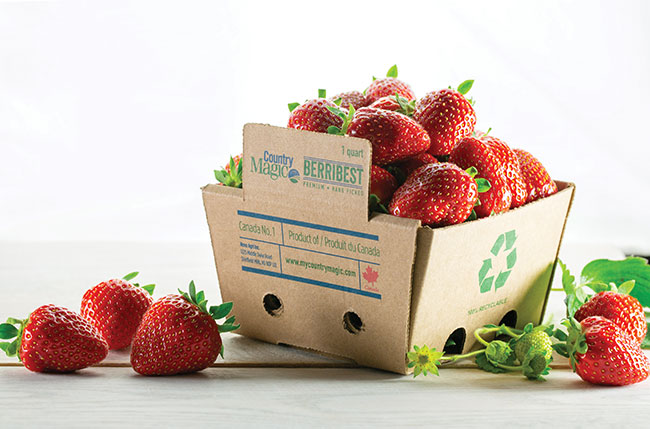
Features
Sustainability
Getting to green
The journey to reducing the industry’s produce packaging footprint.
February 8, 2023 By Nancy Tregunno, Perennia
 Country Magic strawberries in recyclable/compostable cardboard quart with a built-in pop-up label, launched in the 2022 season.
Photo courtesy of Darrell Munro, Balance Creative.
Country Magic strawberries in recyclable/compostable cardboard quart with a built-in pop-up label, launched in the 2022 season.
Photo courtesy of Darrell Munro, Balance Creative. Are you considering changing your packaging materials? Figuring out the best options can be daunting since so many factors go into this decision. On top of supply chain issues and skyrocketing costs, the world is rapidly moving away from plastics to keep them out of the natural environment, reduce carbon emissions and divert waste from landfills. We must find sustainable solutions to every industry aspect while maintaining quality and traceability. Where to start?
First, is there any opportunity to reduce or go packaging-free in aspects of your supply chain? Reusable totes or selling in bulk can have benefits if your produce item does not require grouping, physical protection or additional shelf life. Edible coatings that extend shelf life are becoming a reality for some products. California-based Apeel Sciences (working only with selected partners) recently debuted in Canada with Ontario’s Topline Farms, which started shipping plastic-free English cucumbers in June 2022. Their plant-based protective coating retains moisture and limits oxygen exposure, delaying decay and eliminating the need for single-use plastics. Of course, films must not impact flavour.
Plastic has been a very useful tool over the years to improve food safety, convenience and shelf life. According to the Canadian Produce Marketing Association (CPMA), fresh produce packaging represents only five per cent of total plastics packaging in Canada. However, produce packaging operates throughout an entire supply chain and is very visible to consumers. The industry is transitioning towards more sustainable packaging, such as compostable or readily recyclable materials, and eliminating harmful plastics. Let’s break those terms down.
There is confusion around the meaning of “compostable” versus “biodegradable.” Not all biodegradable materials are compostable, since they can leave behind visible fragments and/or harmful chemicals. Truly compostable materials degrade under specific time-temperature/moisture requirements and don’t release any harmful compounds. Composting facilities across North America with smaller-scale systems may not generate enough heat to break down some of these packages, especially in cooler climates and if they contain a compostable plastic liner that takes time to degrade. Talking to the waste management officials in your markets is a prudent step to determine whether a material meets local compostability requirements.
What exactly is meant by the term “harmful plastics?” Examples include those plastics that are difficult to recycle, such as multilayer films, dark-coloured plastics, polystyrene (PS) or poly-vinyl chloride (PVC), as well as oxo-degradable plastics, which can leave microplastic residues behind as they break down. The CPMA has created an online Preferred Plastics Guide, which outlines the acceptability of different materials to help guide industry to better choices. If plastics are used, try to maximize post-consumer recycled material content and use a mono-material if possible.
This past summer, Nova Scotia’s strawberry industry took steps to improve traceability to align with the requirements of the Safe Food for Canadians Act. The new regulations require producer identification on each retail pack, which was historically not done on traditional wooden strawberry quart baskets. They have become more difficult to source, contain staples (making them incompatible with some municipal composting systems) and are difficult to label.
Perennia Food and Agriculture, SKUFood and Balance Creative undertook a project, with support from the Nova Scotia Department of Agriculture, to identify viable options allowing producers to meet the regulatory requirements to fit within existing recycling programs and to meet the logistical and efficiency requirements of growers (e.g. compatible with existing master packs and pallet configurations). The project team identified potential cost-effective packaging solutions in other markets and commodities. Various options were presented to industry, and different growers tried options like stickers with wood-compatible adhesive or a tag hooked over a quart.
Nova Agri Inc., operating the brand Country Magic, decided to embrace the opportunity to move to a new sustainable package for their tunnel-grown strawberries. Switching to a cardboard quart with bio-wax coating from Maritime Paper offered the ease of printing the producer’s information on the side of the box and gave consumers a fully recyclable option. In addition, the new package seems to provide better protection for the berries, since imperfections in the wood sometimes caused quality issues. The new boxes are similar in price to traditional wooden quarts. Consumer feedback has been positive.
“We are always excited to receive positive feedback about the quality of our produce, but this was the first time we received praise from consumers about our packaging. They liked the functionality of the package and that we got the strawberries into something that can be recycled or composted”, says Susan Sipos, Country Magic account manager, Nova Agri.
Let’s not forget the consumer and retailer viewpoints. “Packaging is a very important part of the consumer brand experience, so food businesses need to pay attention to consumer’s values and insights,” says Dana McCauley, chief experience officer with the Canadian Food Innovation Network. “Likewise, grocers should be part of the packaging development phase; they will want to maximize display units on shelves while minimizing restocking needs. Once these factors have been considered, see which sustainable solutions can be applied to make your products more appealing to your customers and consumers.”
Lastly, getting a clear end-of-life disposal message out to consumers is key to achieving positive change. With a lack of universally mandated symbols, it’s up to industry to give clear composting or recyclability messaging.
Print this page